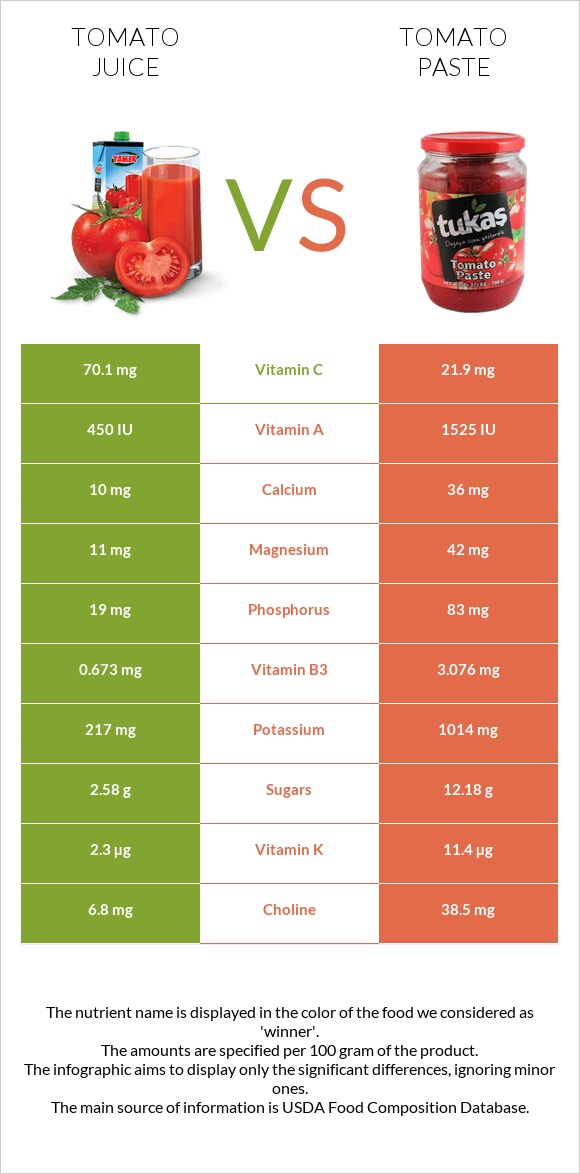Tomato juice vs. Tomato paste — In-Depth Nutrition Comparison
Compare
Important differences between tomato juice and tomato paste
- Tomato juice has more vitamin C; however, tomato paste has more copper, iron, vitamin E, potassium, vitamin A, vitamin B3, fiber, vitamin B6, and manganese.
- Tomato juice's daily need coverage for vitamin C is 54% more.
- Tomato paste has a higher glycemic index than tomato juice.
The food varieties used in the comparison are Tomato juice, canned, without salt added and Tomato products, canned, paste, without salt added.
Infographic

Infographic link
Mineral Comparison
Mineral comparison score is based on the number of minerals by which one or the other food is richer. The "coverage" charts below show how much of the daily needs can be covered by 300 grams of the food.
| Contains less SodiumSodium | -83.1% |
| Contains more MagnesiumMagnesium | +281.8% |
| Contains more CalciumCalcium | +260% |
| Contains more PotassiumPotassium | +367.3% |
| Contains more IronIron | +664.1% |
| Contains more CopperCopper | +769% |
| Contains more ZincZinc | +472.7% |
| Contains more PhosphorusPhosphorus | +336.8% |
| Contains more ManganeseManganese | +344.1% |
| Contains more SeleniumSelenium | +960% |
Vitamin Comparison
Vitamin comparison score is based on the number of vitamins by which one or the other food is richer. The "coverage" charts below show how much of the daily needs can be covered by 300 grams of the food.
| Contains more Vitamin CVitamin C | +220.1% |
| Contains more Vitamin B1Vitamin B1 | +66.7% |
| Contains more FolateFolate | +66.7% |
| Contains more Vitamin AVitamin A | +230.4% |
| Contains more Vitamin EVitamin E | +1243.8% |
| Contains more Vitamin B2Vitamin B2 | +96.2% |
| Contains more Vitamin B3Vitamin B3 | +357.1% |
| Contains more Vitamin B6Vitamin B6 | +208.6% |
| Contains more Vitamin KVitamin K | +395.7% |
All nutrients comparison - raw data values
| Nutrient |  |
 |
DV% diff. |
| Vitamin C | 70.1mg | 21.9mg | 54% |
| Copper | 0.042mg | 0.365mg | 36% |
| Iron | 0.39mg | 2.98mg | 32% |
| Vitamin E | 0.32mg | 4.3mg | 27% |
| Potassium | 217mg | 1014mg | 23% |
| Fiber | 0.4g | 4.1g | 15% |
| Vitamin B3 | 0.673mg | 3.076mg | 15% |
| Vitamin B6 | 0.07mg | 0.216mg | 11% |
| Manganese | 0.068mg | 0.302mg | 10% |
| Phosphorus | 19mg | 83mg | 9% |
| Selenium | 0.5µg | 5.3µg | 9% |
| Vitamin K | 2.3µg | 11.4µg | 8% |
| Protein | 0.85g | 4.32g | 7% |
| Magnesium | 11mg | 42mg | 7% |
| Vitamin A | 23µg | 76µg | 6% |
| Vitamin B2 | 0.078mg | 0.153mg | 6% |
| Choline | 6.8mg | 38.5mg | 6% |
| Fructose | 1.33g | 5.85g | 6% |
| Carbs | 3.53g | 18.91g | 5% |
| Zinc | 0.11mg | 0.63mg | 5% |
| Calories | 17kcal | 82kcal | 3% |
| Calcium | 10mg | 36mg | 3% |
| Vitamin B1 | 0.1mg | 0.06mg | 3% |
| Vitamin B5 | 0.142mg | 3% | |
| Sodium | 10mg | 59mg | 2% |
| Folate | 20µg | 12µg | 2% |
| Polyunsaturated fat | 0.027g | 0.16g | 1% |
| Fats | 0.29g | 0.47g | 0% |
| Net carbs | 3.13g | 14.81g | N/A |
| Sugar | 2.58g | 12.18g | N/A |
| Starch | 0.22g | 0% | |
| Saturated fat | 0.019g | 0.1g | 0% |
| Monounsaturated fat | 0.005g | 0.067g | 0% |
| Tryptophan | 0.006mg | 0.031mg | 0% |
| Threonine | 0.026mg | 0.133mg | 0% |
| Isoleucine | 0.017mg | 0.089mg | 0% |
| Leucine | 0.024mg | 0.124mg | 0% |
| Lysine | 0.026mg | 0.134mg | 0% |
| Methionine | 0.005mg | 0.027mg | 0% |
| Phenylalanine | 0.026mg | 0.13mg | 0% |
| Valine | 0.017mg | 0.088mg | 0% |
| Histidine | 0.014mg | 0.071mg | 0% |
| Omega-3 - ALA | 0.005g | N/A | |
| Omega-6 - Linoleic acid | 0.022g | N/A |
Macronutrient Comparison
Macronutrient breakdown side-by-side comparison
Protein:
0.85 g
Fats:
0.29 g
Carbs:
3.53 g
Water:
94.24 g
Other:
1.09 g
Protein:
4.32 g
Fats:
0.47 g
Carbs:
18.91 g
Water:
73.5 g
Other:
2.8 g
| Contains more WaterWater | +28.2% |
| Contains more ProteinProtein | +408.2% |
| Contains more FatsFats | +62.1% |
| Contains more CarbsCarbs | +435.7% |
| Contains more OtherOther | +156.9% |
Fat Type Comparison
Fat type breakdown side-by-side comparison
Saturated fat:
Sat. Fat
0.019 g
Monounsaturated fat:
Mono. Fat
0.005 g
Polyunsaturated fat:
Poly. Fat
0.027 g
Saturated fat:
Sat. Fat
0.1 g
Monounsaturated fat:
Mono. Fat
0.067 g
Polyunsaturated fat:
Poly. Fat
0.16 g
| Contains less Sat. FatSaturated fat | -81% |
| Contains more Mono. FatMonounsaturated fat | +1240% |
| Contains more Poly. FatPolyunsaturated fat | +492.6% |
Carbohydrate type comparison
Carbohydrate type breakdown side-by-side comparison
Starch:
0 g
Sucrose:
0 g
Glucose:
1.25 g
Fructose:
1.33 g
Lactose:
0 g
Maltose:
0 g
Galactose:
0 g
Starch:
0.22 g
Sucrose:
0.3 g
Glucose:
5.75 g
Fructose:
5.85 g
Lactose:
0 g
Maltose:
0.28 g
Galactose:
0 g
| Contains more StarchStarch | +∞% |
| Contains more SucroseSucrose | +∞% |
| Contains more GlucoseGlucose | +360% |
| Contains more FructoseFructose | +339.8% |
| Contains more MaltoseMaltose | +∞% |
~equal in
Lactose
~0g
~equal in
Galactose
~0g

